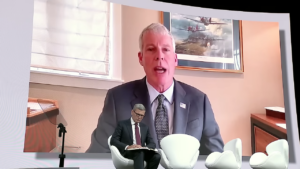Victoria’s new Labor Premier Daniel Andrews has announced changes to wind farm planning laws, effectively repealing the worst parts of the Liberal Baillieu government’s controversial “VC82” suite of laws, which had the effect of shutting down wind energy development in the state.
Among the most important changes are a reduction of the household veto for a proposed wind turbine development from 2km to 1km from a dwelling, and the return of development approval decisions to the office of the planning minister.
The reforms have also created an exemption for community wind projects from the no-go zones set up by Baillieu – a law that, according to Friends of the Earth, imposed blanket bans on wind farms in the windiest parts of the state, including the Macedon/McHarg Ranges and Bellarine Peninsula.
Councils will retain responsibility for enforcement of wind energy facilities for new and existing planning permits.
The Australian Wind Alliance said it supported the changes to what it described as “the worst parts” of the previous government’s wind farm planning laws, but that more needed to be done at a national level to sustain the industry nationally.
“Victoria has been missing out on jobs and regional investment from wind farms for too long and this is the first step towards fixing the problem,” said AWA national coordinator Andrew Bray.
“The previous laws strangled the pipeline of new wind farm investment in Victoria, allowing residents up to 2km away to veto turbines. The fact that a CSG well could be drilled within 500m of a home, yet a wind turbine had a buffer of 2 kilometres never made any sense.”
Bray also noted that, in Opposition, the Victorian Coalition had appointed a shadow minister for renewables, David Southwick – a move he hoped signalled a rethink on renewables from the party.
“There is no value for governments of any persuasion to be blocking the development of renewable energy when its so popular with the electorate.”
Indeed, the anti-wind stance adopted by Baillieu – although in keeping with the views of the federal Coalition and its well-documented dislike of view-spoiling wind turbines – proved not to be a politically savvy move.
Nor was it economically smart. In 2013, Friends of the Earth estimated Baillieu’s anti-wind decisions cost the state around $887 million in lost or stalled investment, 650 direct jobs and a further 1,400 indirect jobs.
In the 12 months after the laws were introduced, as many as 14 Victorian wind farm proposals were rendered unlikely to proceed in the state, and no new proposals were announced.
The Andrews government says its reforms to the planning restrictions will revive Victoria’s wind energy industry and strike the right balance between protecting property and supporting jobs in emerging industries – as well as other economic benefits for regional communities.
Minister for Industry, Lily D’Ambrosio, said Labor’s $200 million Future Industries Fund would also work with the renewable energy sector to boost the creation of jobs and investment.
The government has also announced the development of a Victorian Renewable Energy Action Plan, which will outline a comprehensive set of measures to attract Victoria’s share of renewable energy investment.
The establishment of a $20 million New Energy Jobs Fund will also offer support to community groups and businesses developing renewable energy projects.
“Victoria is open for business,” Premier Andrews said in a statement on Friday, borrowing a line from Tony Abbott, but not his policy stance. “Investors want to come to Victoria and back renewable energy. The Liberals said no. We’re saying yes.”
Perhaps even more encouraging, though, is this statement from the minister of planning, Richard Wynne:
“We said we would restart the industry by encouraging community wind farms and today we’re keeping our word.
“These changes will support our wind farm industry – creating jobs, providing clean energy to our homes and minimising our impact on the environment.”
The Clean Energy Council has welcomed the reform, saying the effort would help to unlock billions of dollars in renewables investment – as long as a bipartisan deal could be reached on the national Renewable Energy Target (RET).
“It is important to get the balance right between attracting renewable energy investment to Victoria and ensuring that the voice of communities is heard when building a wind farm,” said CEC policy director Russell Marsh.
“The restrictions introduced by the previous government simply drove wind farm companies to other states and robbed Victoria of investment and job opportunities in regional communities.”
Green group, Friends of the Earth, has also welcomed the changes, but stressed that the Andrews government announcement should pave the way for broader reform of wind energy planning laws.
“Labor’s pledge to exempt community-initiated projects from wind farm restrictions is sensible policy. Yet, the blanket bans on wind farms still prohibit projects that enjoy strong community support,” said Friends of the Earth spokesman Leigh Ewbank.
“We look forward to Labor’s plan to drive the rollout of renewable energy in Victoria now that it has shown intent to remove barriers to the sector,” Ewbank said, adding that this would require the state committing to its own renewable energy target.
Meanwhile, in other news, Big Four bank NAB has reportedly organised a $205 million financing deal for a wind farm in mid-north South Australia, using the US private placement market – a move that the bank is claiming as a first.
The Australian newspaper said on Friday that the Hallett Hill (HH2) wind farm was initially project financed by NAB and recently moved to the production phase, at which point the financing approach changed.
The new placement is understood to have a term of 12 years, which NAB says is longer dated than most maturities generally available in Australia.
The Hallett Hill Senior Secured Notes have an issue rating of BBB (stable) from Standard & Poor’s and have reportedly been verified in accordance with Green Bond principles by an organisation called DNV GL, the paper said.










